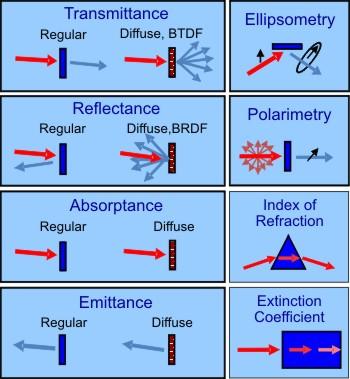Summary
Accurate measurements of the optical properties of materials in the infrared spectral range play an increasingly important role in the aerospace and defense industries, optical engineering, condensed matter physics, remote sensing, radiative heat transfer measurements and related areas. Our facilities have been developed for high accuracy infrared reflectance, transmittance and emittance measurement over the wavelength range of 1 µm to 20 µm and beyond.
Description

Our overall program can be summarized by the following 6 key elements:
- Provide a traceability path to national scales for infrared optical properties to the infrared optical properties community through, NIST Calibration Service 38075S, Standard Reference Materials, cooperative research and development and other agreements, as well as to disseminate knowledge and expertise via short courses, workshops, conferences and publications.
- Development of a comprehensive measurement capability for the infrared spectral region encompassing a wide range of optical properties, for the characterization of a wide range of material types (including specular & diffuse, transmissive & opaque), and covering a wide range of critical parameters (including temperature, beam geometry, polarization state, wavelength range, and property level);
- Evaluation and development of absolute measurement methodologies and instrumentation for high accuracy, as we have done for directional-hemispherical reflectance, by the use of an integrating sphere method for specular samples, and the use of Monte Carlo modeling techniques for analysis and optimization of the instrumentation designs;
- Investigation and understanding of major sources of measurement error, both hardware and software related, including detector spatial non-uniformity and non-linearity, sample-detector-spectrometer inter-reflections, etc. A critical element to this effort is the last key concept in which comparisons using different methods helps to elucidate any overlooked error contributions.
- Development, design and implementation of custom accessory instrumentation for absolute measurements, based on minimization of errors, instrument characterization and modeling analysis. Systems we have developed include: a goniometer for variable angle absolute specular reflectance and transmittance, an integrating sphere for specular and diffuse samples, an Infrared spectral emittance system, a cryostat for variable temperature reflectance and transmittance, a polarimeter for polarization dependent and Mueller matrix measurements, a temperature-dependent emittance measurement system, as well as laser-based systems, for bi-directional reflectance distribution function measurements and black cavity emittance/absorptance;
- Intercomparison with other techniques and other Laboratories, as for example, comparison of transmittance measured with FTIR and laser systems, and emittance with reflectance from separate systems. Comparisons of transmittance, reflectance and emittance have been made with other NIST facilities as well as with other National Metrological Institutes from around the world.
| Quantity: | Reflectance and Transmittance | Emittance | ||
|---|---|---|---|---|
| Measurement Technique | Relative Flux Ratio | Radiance Comparisons | ||
| Integrating Sphere | Goniometer & Cryostat | Comparison w/ Blackbody Reference Sources | ||
Temperature Range, K (°C) | 295 to 475 (20 to 200) | 10 to 775 (-265 to 500) | 425 to 1175 (150 to 900) | |
| Spectral Range (µm) | 1 to 18 | 1 to 20 | 3 to 20 | |
| Temperature Measurement Technique | Contact | Non-contact | ||
| Sample Type | All | Specular | Opaque | |
| Special Features | Custom Absolute Methods for both Specular and Diffuse | Simple Absolute Method | Spectral Directional Emittance | Use Sphere-based Reflectometry |
| Incidence Angle | 8° | 8° to 80° | 0° to 70° | |
| Relative Expanded Uncertainty, % (k = 2) | Diffuse 1.5 – 3.0 Specular 0.3 | 0.5 – 1 | 0.5 – 1.5 for ε ≥ 0.1 | |
For information about special test services, see Optical Radiation Measurements calibration page.
Created February 2, 2010, Updated March 26, 2025

